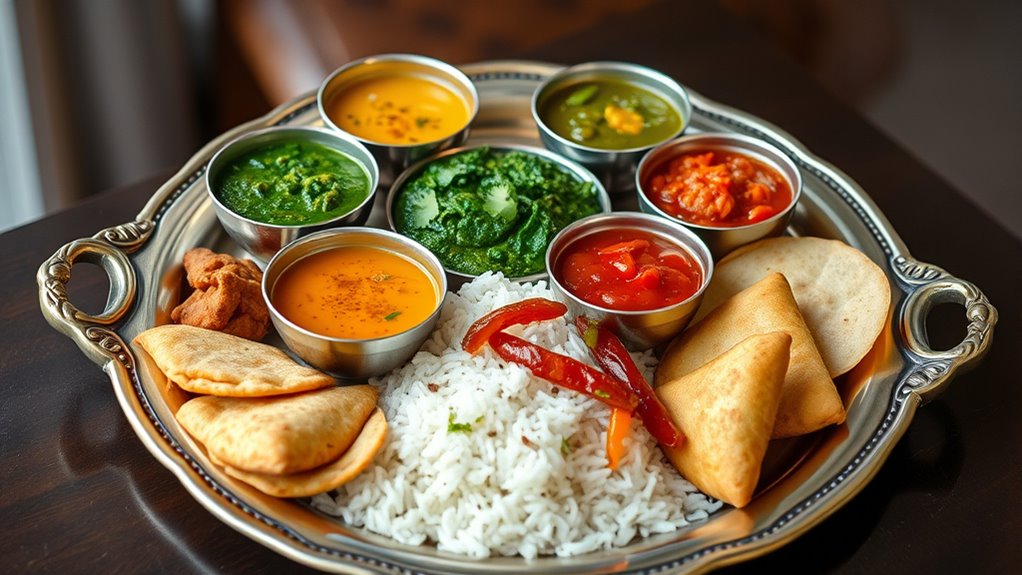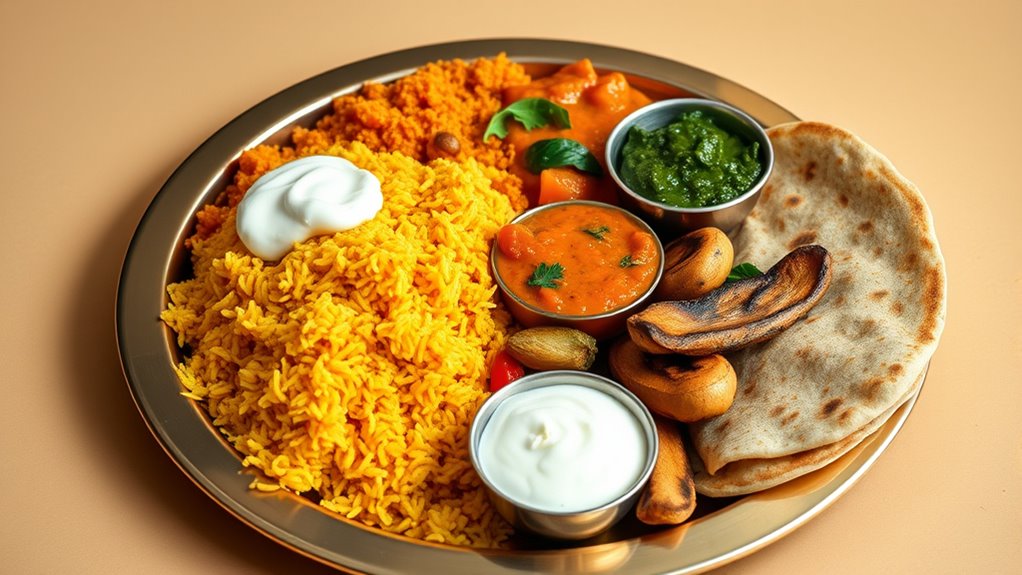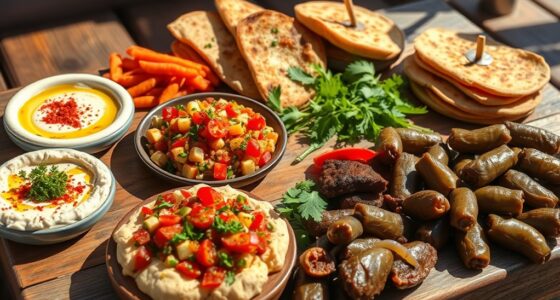An Indian Thali offers a balanced lunch plate by including rice or bread, vegetable dishes, lentils or beans, and often pickles or chutneys, providing a mix of carbs, protein, fiber, and vitamins. Each regional variation brings unique flavors and ingredients, reflecting cultural traditions. Whether vegan, gluten-free, or vegetarian, it’s designed to nourish your body while celebrating India’s culinary diversity. Explore further, and you’ll uncover how each component contributes to harmony and health in every meal.
Key Takeaways
- A traditional Indian Thali includes rice or bread, vegetable dishes, lentils or beans, pickles or chutneys, and sweets or yogurt.
- It offers a balanced mix of carbohydrates, proteins, fiber, vitamins, and minerals for complete nutrition.
- Regional variations reflect local ingredients and culinary traditions, such as North Indian naan and curries or South Indian rice and sambar.
- Thalis are often vegetarian, with options for vegan, gluten-free, and non-vegetarian preferences, ensuring dietary inclusivity.
- The meal emphasizes harmony, variety, and cultural richness, providing a satisfying and holistic dining experience.

Have you ever wondered what makes an Indian Thali so special? It’s more than just a meal; it’s a vibrant reflection of India’s diverse culinary traditions. Each Thali is a carefully curated platter that showcases a variety of flavors, textures, and colors, making it a balanced and satisfying lunch. One of the reasons it feels so authentic and unique is because of its regional variations. In North India, you might find a Thali featuring naan or chapati, rich curries, and lentils like dal. South Indian Thalis often include rice served with sambar, rasam, and an assortment of vegetable stir-fries. In the West, Gujarat and Rajasthan offer vegetarian Thalis packed with spicy, tangy flavors and an array of pickles and chutneys. Each region adapts the Thali to its local ingredients, climatic conditions, and culinary traditions, giving you an experience that’s deeply rooted in local culture.
Indian Thalis reflect regional flavors, ingredients, and traditions, making each a unique and colorful culinary experience.
Dietary adaptations also influence what goes onto your Thali. Many Thalis are vegetarian, reflecting India’s long-standing vegetarian traditions, but there are also non-vegetarian options, especially in coastal regions where seafood is prominent. If you follow specific dietary restrictions, like veganism or gluten-free diets, there are tailored Thalis that accommodate these needs without sacrificing flavor or variety. For example, vegan Thalis might emphasize lentils, vegetables, and dairy alternatives, while gluten-free versions replace wheat-based bread with millet or rice-based options. This flexibility guarantees that everyone can enjoy a balanced, nutritious meal that aligns with their lifestyle and beliefs. Additionally, the nutritional balance of a Thali is carefully maintained through the diverse components included in the platter.
The components of a Thali are designed to provide a balanced intake of nutrients. Typically, it includes a serving of rice or bread, a couple of vegetable dishes, a lentil or bean preparation, pickles or chutneys, and sometimes a sweet dish or yogurt. The combination of these elements ensures you get a good mix of carbohydrates, proteins, fiber, and essential vitamins. The variety also encourages you to taste different flavors with each bite, making the meal both nourishing and pleasurable. The careful arrangement of these items reflects India’s emphasis on harmony and balance in a meal, emphasizing that good health and good taste go hand in hand.
In essence, an Indian Thali isn’t just about satisfying hunger; it’s about appreciating India’s culinary diversity, regional variations, and adaptability to different dietary needs. It’s a full-circle experience that celebrates tradition while allowing for modern dietary choices, all on a single, beautifully arranged plate.
Frequently Asked Questions
What Are the Regional Variations of Indian Thali?
You’ll notice regional variations of Indian thali reflect local flavors and cultural influences. In North India, thalis often feature rich curries, bread like naan, and sweets, while South Indian thalis emphasize rice, sambar, and dosas. Western regions may include seafood and unique spices, whereas East India highlights sweets and fish. These differences showcase how local ingredients and traditions shape each region’s distinct thali, offering a diverse culinary experience across India.
How Can I Customize a Thali for Dietary Restrictions?
You can customize your thali for dietary restrictions by choosing gluten-free options like rice, millet, or buckwheat, and replacing wheat-based items with gluten-free grains. For vegan substitutions, opt for dal, vegetable curries, and chutneys, and skip dairy or ghee. Feel free to add fresh salads and fruits to enhance nutrition. Communicate your needs clearly when ordering, ensuring your thali aligns with your dietary preferences.
What Is the History Behind the Indian Thali Tradition?
You might think the Indian thali is just a meal, but it’s rooted in deep cultural significance and a rich historical evolution. It dates back centuries, symbolizing unity and balance in Indian life. Over time, regional influences shaped its variety, yet the core idea remains: offering a complete, nourishing experience. This tradition reflects India’s diverse heritage, making every thali a meaningful connection to history and culture.
How Do I Properly Serve and Eat an Indian Thali?
To properly serve and eat an Indian thali, start with proper serving techniques by arranging dishes neatly around the main plate, using small bowls for curries and sides. Adopt good eating etiquette by using your right hand to mix rice and curries, taking small bites, and savoring each flavor. Keep the thali clean and avoid wasting food. This respectful approach enhances your experience and shows appreciation for the meal.
Are There Specific Occasions When Thali Is Traditionally Served?
You’ll find thali served during festive celebrations and religious ceremonies, as it symbolizes abundance and tradition. Families often gather to enjoy a thali during festivals like Diwali or Navratri, and it’s also common at religious events or temple visits. These occasions highlight the cultural significance of sharing a balanced, hearty meal. So, whenever you attend such celebrations or ceremonies, expect to experience the rich tradition of a well-prepared Indian thali.
Conclusion
So, next time you enjoy an Indian thali, remember it’s more than just delicious—it’s a balanced mix of nutrients. Did you know that a typical thali can include up to 20 different items, offering a variety of flavors and health benefits? This vibrant platter not only satisfies your taste buds but also fuels your body with essential vitamins and minerals. Embrace the diversity on your plate and savor the wholesome goodness of an authentic Indian meal.








